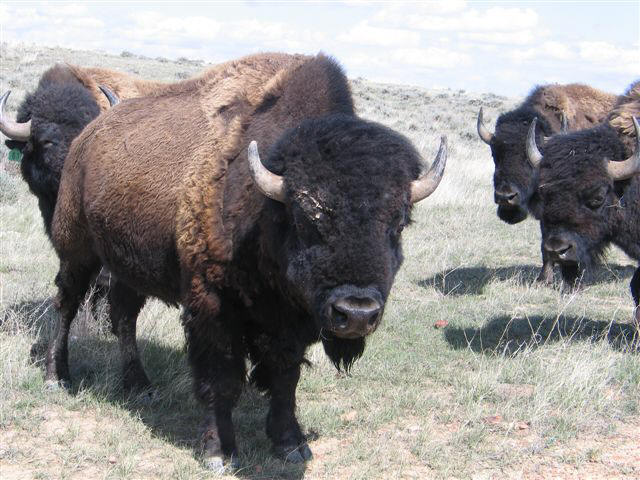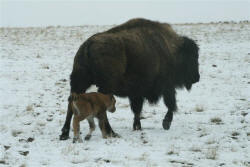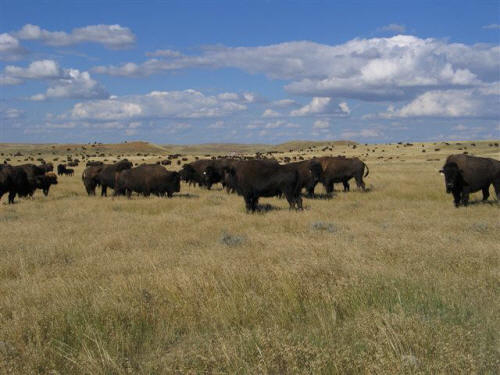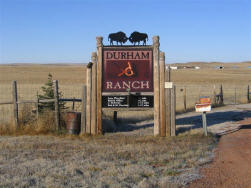



Bison Production In The US
A low cost of production and easy maintenance animal, with meat which is high in nutrients and low in fat - the bison is making a comeback. Charlotte Johnston, TheCattleSite junior editor speaks to John Flocchini who farms bison in the Northern Great Plains.
Background
Being involved in the meat business, running Durham Meat (now Sierra Meat) in California, Mr Flocchini's family bought Durham Ranch in the mid sixties.
Bison were already present on the land having being transported from Yellowstone National Park.
When moving onto the 55,000 acre ranch the family discovered that over 40 per cent of the herd were infected with brucellosis. They gradually started to re-build the herd from the 350 remaining, and today 4000 head of bison roam the ranch during the peak season.
Breeding
Mr Flocchini aims to keep at least 1,200 breeding cows on the ranch, with up to 20 per cent of heifer calves retained as replacements.
Cows are bred at two years old - at the earliest. Mr Flocchini says that the younger animals have the lowest conception rate as animals are not fully mature, fertility of a two year old animal could be 10 - 15 per cent lower than that of mature animal.
The fertility rate of mature animals is around 90 per cent and the gestation period is nine months.
Bulls run with the cows all year round. Cows are pregnancy tested in early Winter and those that are barren are sold for meat.
Cows calf once a year between April and May, the calving season is no longer than 60 days, say Mr Flocchini.
However, Durham Ranch is currently experimenting with the breeding programme.
Last year calving was pushed later into the Spring (May/June), by pulling the bulls out. More grass was available to both cows and calves which allowed cows to get back into shape faster for the next breeding season. However with weaning taking place in November, Mr Flocchini found that calves were on average 50 pounds lighter at weaning time, than when calving took place between April and May.
Mr Flocchini says that no assistance is required at calving, and there are very rarely problems with only a small per cent of losses. He says that as cows calf at three years and older, problems are few and far between due to the natural size of the animals.
Durham Ranch also sells breeding stock across the world. Although Mr Flocchini says that the breeding stock market has been very quiet for the past few years, as a result this side of the business has suffered. However he is confident that the market will pick back up as the demand for meat grows.

Rearing
All animals stay out on grass throughout the winter, but are fed a supplement of hay of about five pounds per day per cow. They also receive a couple pounds of a grain supplement each day.
Mr Flocchini says that these extra supplements are needed as the wind chill factor can be -50 degrees Celcius on some days during the winter. With this in mind, he says that a 10-15 per cent body condition loss is acceptable.
As soon as the grass begins to grow, bison reject the supplements until the following winter.
As said above, calves are weaned in the first week of November, and when born between April and May, weigh about 60 pounds.
Once weaned, any calves or breeding animals that are going off the farm will be vaccinated against brucellosis. Those that remain on the ranch receive nothing until the following Spring, when the yearling herd will be vaccinated against brucellosis.
Brucellosis is a contagious disease that affects cattle, elk, bison and humans. Although it has been eradicated from most of the US, it still exists in elk and wild bison in Yellowstone National Park, which includes northwest Wyoming. If brucellosis infects domestic animals, costing testing restriction are imposed in an attempt to manage the disease.
Mr Flocchini says that vaccinating the youngstock gives the ranch flexibility if they wish to sell some stock later on.
Management
A female is fully mature at around four to five years of age, where as a male is fully mature at five to six years of age.
According to literature, Mr Flocchini says that bison can live to 40 years old, however on average in his herd the oldest are 15 to 16 years.
He does however recall having a cow that was 21 years of age and still breeding!
Health
Mr Flocchini says that bison will take care of themselves and that there are very rarely any health problems. They can contract bovine tuberculosis, however not a lot of research has been conducted on this condition in bison.
The main disease which is the biggest concern to Mr Flocchini is malignant cottavel fever (MCF). The disease is carried by sheep. The virus is commonly shed from lambs between six to nine months of age and will kill 75 per cent of bison exposed. Strangely the disease rarely kills cattle.
There is no vaccination at present for this, however recent research by the ARS has explained the viral life cycle of the disease, which brings the industry a step closer to creating a vaccine.
Mr Flocchini says that the best management is to control where the bison graze.

Grazing
With 65 fields, the largest been 1200 acres, the bison are moved as frequently as needed. During the shorter growing season they could be moved every two to three days, whereas during the peak growing season once a week.
Mr Flocchini says that time spent grazing depends on the time of year as well as the growth rate of grass - as it is important that the animals receive enough nutrients.
Fields will have a resting period of between 90 to 120 days.
Handling
Bison do not like been handled, says Mr Flocchini. While he wouldn't call them aggressive they are far from domesticated.
Specialist handling facilities are required, with alleyways reaching seven foot high. Bison have one more rib than standard beef cattle, and so the crush is specially designed to be longer and due to their natural size - heavy duty.
Strong six and a half foot fences mark the perimeter of fields, where as high voltage electric fences (2-3 wires) are used internally.
Mr Flocchini says that the handling equipment is by far the largest cost when producing bison.
Attitudes
Speaking about the nature of bison, he says their first instinct is too run. However saying that, like any animal, cows are protective of their young and bulls can be very aggressive during the breeding season.
Culling
Cows are tested for milk in the Autumn, if they don't have milk in their bag it is likely they lost a calf, says Mr Flocchini and these animals are culled. Those who are not pregnant when tested in early winter are also culled. This, he says, means that a strong healthy herd is maintained.
Meat production
Animals that are sold for meat will weigh about 1100 pounds and be around two years of age.
Some animals are finished in pasture whereas others will be sent to feedlots and finished on grain.
Mr Flocchini says this decision depends on a number of different factors, such as grass conditions and feed prices.
Animals achieve on average a carcase yield of 58 per cent on a chilled weight basis.
They are slaughtered at a USDA approved plant near to the ranch which is a small family owned business.
By-products include offal which is commonly used in dog feed, including the hearts and livers. Mr Flocchini says that the market for hearts and livers on the meat market has not developed very well, hence these products are put into dog food and other by-products.
Hides and skulls are used for leather and decorative purposes, the hide is also used for robes and rugs which are popular in the winter.
Marketing meat
Mr Flocchini says that the demand for bison meat is strong and constantly growing, due to it being a naturally healthy product.
It has been difficult to increase the market for bison, he says, particularly as the meat is so lean, which means that it must be prepared differently.
Mr Flocchini says that this may put some people off from buying the product, as if over cooked, the meat is unpalatable.
Bison meat from Durham Ranch is sold to a number of catering businesses across the US and distributors. It is also sold by Sierra Meat, Mr Flocchini's family meat company.

About bison
Despite increasing in numbers, bison is still a niche market in the US. In 2009, 54,000 bison were processed under USDA inspection, with a further 20,000 under state inspection. By comparison, the US beef industry processes roughly 125,000 cattle on an average day.
Mr Flocchini has recently been appointed as President of the National Bison Association. He says that he is working towards expanding membership of the association, with both current producers and encouraging other people to go into bison production.
He highlights this is particularly important as demand is increasing, whilst supply is remaining stagnant.
A breed of foragers who require no artificial shelter, live long productive lives, require little human intervention and restore the prairies - will bison have a strong future in the US meat market?


